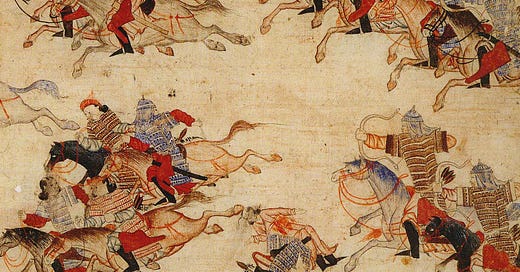Earlier today, I was lamenting how much of Spengler’s work has yet to be translated into English. Significant headway has been made in recent years thanks to a new translation of Spengler’s Frühzeit der Weltgeschichte. And, thankfully, there are a few of us online translating Spengler’s shorter works here and there. But still, so much remains inaccessible to Anglophone discourse. Spengler’s doctoral dissertation on Heraclitus, his posthumous volume on metaphysics, and an assortment of essays on prehistory remain stuck in German.
Rather than wallowing in monolingual despair, I got to work on translating one of Spengler’s shorter works on history, titled “Altasien” [Ancient Asia].
John Farrenkopf’s Prophet of Decline gives us some important background information on this fragmentary text. If you want to just read the translation, skip ahead.
“The abrupt shift in Spengler’s interests from politics and intrigue to the study of prehistory and the antecedents of civilizations was highlighted by two events in the fall of 1924. In October of that year, at a conference of the German Oriental Society, the mature scholar who had loved cartography as a school boy eloquently pleaded for a collective, interdisciplinary cartographical effort by German scholars. He recommended that they assemble a comprehensive collection of maps as an essential tool in the study of prehistory and world history. Spengler argued that students of prehistory and early civilizations were doubly hindered, both by the absence of maps for important periods and by the tardiness with which available maps were updated. His appeal for a major cartographical effort highlights his changing views on cultural interaction. Spengler’s daring thesis of the autonomous character of civilizations, their relative insulation from external civilizational influences, continues to receive deservedly much criticism. However, in discussing his ‘Plan eines neuen Atlas Antiquus’ (‘Plan For a New Atlas of Antiquity’), he showed a strong interest in going beyond his thesis of cultural individuality to explore the role of cultural interaction in universal history. Spengler visualizes primitive cultures engaging in dynamic interplay. ‘The primitive cultures encompass the entire earth, they have used all the seas along the coasts and island chains as go-betweens and form, with their spheres and currents a living whole, without which one is not able to survey the origin and prior history of the great cultures.’ He now conceived civilizations to be involved in significant cultural interchange. Thus, the Sassanid Empire is characterized as ‘a most decisive creation at the crossroads of four high cultures.’ One week after this lecture, Spengler completed a five-page sketch entitled ‘Altasien’ (‘Ancient Asia’). The outline attests to his ambition of developing a new vision of universal history. It would encompass prehistory, the historical antecedents of civilizations, and the interactions of these ‘precivilizations’ in recorded history, key topics ignored in The Decline of the West.” (Farrenkopf 189-190)
Personally, I am not entirely convinced that Spengler was planning on a complete revision of his historical overlook. As I’ve said in the past, the main point of the book still stands (the West’s impending doom and the need to muster whatever strength it still has to have a noble and heroic decline). But academics always fail to understand that the book is not addressed to them but, instead, to the young German men Spengler hoped would lead the West into its “Roman” era.
That aside, what is most striking is Farrenkopf’s mentioning of Spengler’s cartographical penchant. The young Spengler would spend much of his free time laboring on imaginary empires complete with pseudo-historical accounts and detailed maps. Spengler, the sensitive young man, makes a reappearance here in Altasien where he ends the sketch with a call for carefully curated selection of images and maps for the forthcoming volume.
It appears that Altasien was really just a sketch of a book he had in mind (and which may have been the impetus behind his collection of notes and musing on prehistory found in Early Days of World History). The publication of Altasien occurred after his death (I believe in 1939, but Farrenkopf is a bit vague) in the journal, Die Welt als Geschichte (The World as History). The journal itself is of some interest to us since its name is a reference to one of Spengler’s major concepts in DOTW Vol. 1 (The World-as-History vs. The World-as-Nature). The journal’s founder, Hans Erich Stier, was a student of Eduard Meyer’s and an accomplished professor of ancient history in his own right. The fate of that journal is another interesting story for another time. Here’s what it looked like:
Interestingly, there exists a few letters between Spengler and Stier in Spenglers Briefe. One of which includes Spengler outlining his plans for a series of 10 articles on various subjects of prehistory. Ostensibly, these would all have been published in Stier’s journal had he not died a bit prematurely in 1936. Alas…
Some of the published ones have already been translated (see
’ translation of ‘The War Chariot and its Importance in World-History). Tartessos and Alaschia also exists in the posthumous volume Reden und Aufsätze but has yet to be translated (no doubt thanks to its monstrous size). For others, we have only the title. But perhaps, thanks to Frühzeit der Weltgeschichte, we might be able to reconstruct the arguments Spengler would have made. A project for the foreseeable future, I suppose…And without further ado, I present to you the first step forward in translating Spengler’s remaining works. It’s only taken a century to do! And forgive me, dear free subscribers, for this has been paywalled.
ANCIENT ASIA
Tasks and Methods
The plan for this book assumes that it will open a series of works dealing with the historical problems of Asia. Consequently, I consider it right not to summarize here the results obtained so far, which must be reserved for subsequent works, but to develop the whole complex of half-solved or unresolved questions, new methods, surprising outlooks and goals, so that future research can at least have an overview of their field in broad outlines. For this reason, I will refrain from expressing my own opinion in order to emphasize the full significance of the multitude of prevailing opinions.





